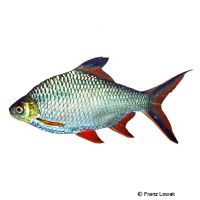Red Tailed Tinfoil (Barbonymus altus)
| Red Tailed Tinfoil Barbonymus altus | |
|---|---|
| Name | Red Tailed Tinfoil |
| Name Lat. | Barbonymus altus |
| Family | Carps |
| Family lat. | Cyprinidae |
| Order | Carps |
| Order lat. | Cypriniformes |
| Origin | Southeast Asia |
| Habitat | Rivers |
| Diet | Omnivore |
| pH | 6.0-7.0 |
| Behavior | Peaceful |
| Keeping | Group |
| Care Level | Moderate |
| Reproduction | Egg scatterer |
| Breeding | None reported |
| Life Span | 8-10 years |
| Protection | No |
| Metric Units | |
| Size | 15-25 cm |
| Temperature | 22-25 °C |
| Hardness | 5-10 °dH |
| Aquarium | 300 l |
| US Units | |
| Size | 5.9"-9.8" |
| Temperature | 72-77 °F |
| Hardness | 89-178 ppm |
| Aquarium | 80 gal |
Distribution and habitat
The distribution area of the redfin barb is in Thailand, Laos Cambodia and Vietnam, where they occur in the river systems of the Mekong, the Chao Phraya and the Mae Klong. There they live in the larger and medium rivers and their floodplains.
Maintenance
The aquarium should have a varied, robust planting that provides shelter as well as swimming space and roots that serve as a retreat. With bright lighting and dark substrate they show the most beautiful coloration.
No ammonia, ammonium and nitrite should be detectable, the nitrate value should not exceed 100 mg/l. To ensure the water quality and oxygen content, a filter and heater adapted to the aquarium size is required, as well as lighting for the species-appropriate day-night rhythm of the animals.
Diet
The food supply consists of live, frozen and dry food. For a balanced diet, feed once a day with a high-quality dry food (flakes, granules, pellets) as well as cyclops, daphnia, mosquito larvae, artemia and tubifex (live or frozen). In addition, they need vegetable food, such as crushed peas, mashed leafy and wild vegetables, algae leaves or dry food with vegetable ingredients (e.g. spirulina, kelp).
Only feed as much as will be eaten within a few minutes. A regular and varied diet promotes health and prevents deficiency symptoms.
Behaviour and compatibility
These sociable and lively fish should be kept together in a group of at least 5, but preferably more. They can be well socialized with catfish, cichlids, tetras and other barbs of similar size
Basically, only compatible fish species with similar water condition and water temperature requirements should be socialized.
Sex dimorphism
No external sex differences are known. Females appear slightly rounder than the males.
Reproduction and breeding
They are free spawners that do not perform any brood care. There are no known reports of successful breeding in the aquarium.
Important
The Barbonymus altus are very similar to the Barbonymus schwanefeldii.
The well-being of the fish should be checked regularly. Temperature should be checked daily, pH, hardness and nitrate levels at least every 14 days. Regular partial water changes are recommended, even if the contaminant level has not yet reached the upper limit. Sudden changes in water quality should be avoided. Newly introduced fish must be accustomed slowly to the water in the aquarium
Further literature can be found in your pet store.
References
Text: petdata; Image: petdata
Source: BMELV (1998): Tierschutzgutachten - Haltung von Zierfischen (Süßwasser); RIEHL & BAENSCH (2004): Aquarien Atlas Bd. 3, Mergus Verlag; ENGELMANN (2005): Zootierhaltung - Tiere in menschlicher Obhut: Fische, Verlag Harri Deutsch
- Gemäß § 21 Abs. 5 Tierschutzgesetz idgF
